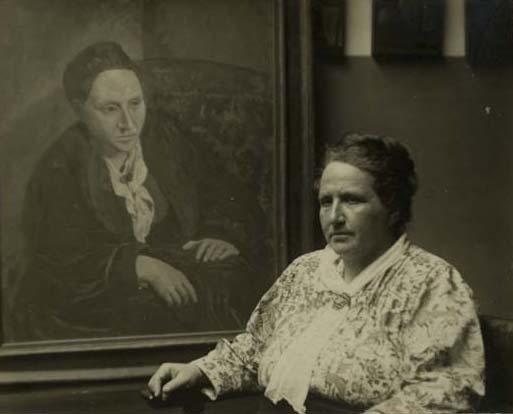Gertrude Stein (1874-1946) disseminated the memories of her life in two important books, which are the most widely read ones among her extensive and partly still little known literary work here in Europe. In 1933 she published The Autobiography of Alice B. Toklas (Alice Toklas was her partner until the end). Everybody’s Autobiography was released in 1937, followed, finally, by Wars I Have Seen in 1945. Moreover, she wrote various self-portraits in her youth and scattered pieces regarding her personal stories.
In reading the new biography written by Philippe Blanchon («Biographies», Folio, Gallimard, 302 pages), unfortunately, I was sorry for the lack of inspiration and depth in this work, which does not offer new insights into her personality or her work. In fact, many important things are missing, the notes are scarce, the bibliography is incomplete. Yet biographies and essays in English on the writer are not lacking!
Gertrude Stein was born in Allegheny (USA, Pennsylvania) into a wealthy Jewish family. His father had interests in the real estate business and ran a tram company. She is the youngest of five siblings. When her parents, of German origin, decided to settle in Vienna, she was only one year old. Back in America, the family settled first in Baltimore, then in Oakland on the west coast. She had a strong bond with her brother Leo, who was two years older than her. They studied at a private school in Oakland.
After their mother’s death, Leo went to study in Berkeley and Gertrude began to appreciate English literature, with a preference for Fielding, Smolett and Thackeray. When their father died in 1891, Leo and Gertrude moved to San Francisco to their elder brother Michael. After another year, Leo went to study at Harvard and Gertrude moved back to Baltimore at her aunt.
In her years at Radcliffe College, from 1893, she became a pupil of William James, a relative of Henry James. Thus, she discovered the stream of consciousness that her professor had theorized in the essay The Principles of Psychology (1890). Experiments in automatic writing with Leon Solomons. This is an aspect of the experience of writing that Gertrude Stein did not know, but that she will not fully accept (as she wrote in the essay The normal automatism of mobility of 1896). All this will have a strong influence on her view of literature.
Later, Gertrude Stein decided to enrol at John-Hopkins Medical School. In 1895, she travelled for a long time to Europe with Leo. Thus she discovered Paris and let herself be charmed by the Louvre museum. Her brother decided to live in Paris and Gertrude joined him a year later, followed by his older brother Michael and his wife.
They lived together in Rue de Fleurus and began collecting works of art, although they did not have the same tastes. Leo took an interest in Cézanne and Matisse, buying several of their paintings starting in 1905. They invite friends, writers and artists on Saturday evenings. But Gertrude soon separates from her brother and began living with her secretary, Alice B. Toklas. The brothers shared the collection and Gertrude was increasingly interested in Cubism and Avant-garde. She began writing The Making of Americans, which will be published in 1925 and which Leo did not like at all, Three Lives, QED and then Tender Buttons.
She also continued her parlour tradition with artists, writers and intellectuals, of which she was then the central figure. She met FS Fitzgerald, Ernst Hemingway, Max Jacob, André Derain, Marie Laurencin, Picasso of course, who was her favourite artist, and of whom she bought many works managing to get her own portrait in 1906. She also had contact with Gris, Braque and later Balthus.
After the war, the Rue de Fleurus residence continued to remain an important meeting and reference point in the cultural geography of the Ville Lùmière. Gertrude Stein continued to write, and a lot. But her books did not appeal to publishers at all and only the publication of Autobiography of Alice B. Toklas met with some success with the public. Her art collection made her famous, with the emergence of Cubism as an important current of the century.
From October 1934 to May 1935 she undertook a long tour of conferences in the Us, managing to attract a large audience, but many listeners did not understand her interventions … Not even her attempt to write a crime, Blood in The Dining Room Floor of the 1933, convinced the readers. All her theatrical production remained on paper.
She tried later, in 1946, to make her way onto the stage with the librettos of Four Saints in Three Acts (1928-1934) and The Mother of Us All, with music by Virgil Thomson (1896-1989), a composer who had a close relationship with the Group of Six in Paris. But her only major success was her little book dedicated to Picasso, which came out in 1938 accompanied by shots by Cecil Beaton.
Two years later Paris France was appreciated, but Gertrude Stein never established herself as a writer capable of meeting the tastes of a large number of readers. Even today, despite the numerous publications in the Us and the translations into many European languages, she remains a strange and contradictory case. Famous, no doubt, however, she is not seen as a great writer of the twentieth century. Her experimental writings remained difficult to access, despite the fact that poets and novelists of the avant-garde (Dadaists, Futurists, Surrealists, and so on) are now part of the history of literature. The collector is celebrated, the writer much less.








